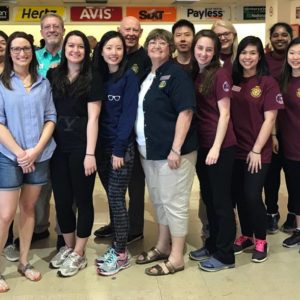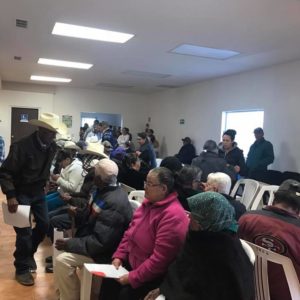 In March, I went on a Student Volunteer Optometric Services to Humanity (SVOSH) trip with eight other University of Houston College of Optometry (UHCO) students to the VOSH Guerrero clinic, which has been helping the indigenous population in the state of Chihuahua, Mexico for over three decades. We joined a group composed of two students from State University of New York (SUNY) College of Optometry, opticians, surgical nurses, and other volunteers helping in whatever capacity they could. Two ophthalmologists from Alabama and the Dominican Republic worked alongside Mexican ophthalmologists to perform hundreds of cataract surgeries. Flying into the airport, we were first led to a dinner held by the Angeles Para Ver (Angels to See) organization in recognition of notable volunteers with the Guerrero clinic, including UHCO alumni Dr. Tom Pruett and VOSH Director Walter Branson for their numerous years of service.
In March, I went on a Student Volunteer Optometric Services to Humanity (SVOSH) trip with eight other University of Houston College of Optometry (UHCO) students to the VOSH Guerrero clinic, which has been helping the indigenous population in the state of Chihuahua, Mexico for over three decades. We joined a group composed of two students from State University of New York (SUNY) College of Optometry, opticians, surgical nurses, and other volunteers helping in whatever capacity they could. Two ophthalmologists from Alabama and the Dominican Republic worked alongside Mexican ophthalmologists to perform hundreds of cataract surgeries. Flying into the airport, we were first led to a dinner held by the Angeles Para Ver (Angels to See) organization in recognition of notable volunteers with the Guerrero clinic, including UHCO alumni Dr. Tom Pruett and VOSH Director Walter Branson for their numerous years of service.
The VOSH group on this trip had put on multiple clinics in years past. Therefore, they had the logistics of the eye care services well taken care of. We stayed in housing similar to a motel near the clinic. There were no televisions, allowing more time to speak with and get to know everyone else. The food was delicious and guacamole was available at every meal! Mmmmm. We were also fortunate enough to be treated to meals cooked by members in the community.
Working together in groups of two or three, we screened patients for cataract surgeries and provided spectacle prescriptions to have glasses made in a small optical area. The threshold used to qualify for cataract surgery was similar to the requirement for visual impairment (BCVA 20/70 or worse in the better seeing eye).

Here are a few things that stood out about the trip:
1. The people value a chance to receive eye care. Seeing those less fortunate with a lack of access to health care traverse hundreds of miles and wait in long lines was a very humbling experience. It also reminded me to not take vision for granted, as the patients we served certainly did not. It was incredibly rewarding to see the significant improvements in vision that cataract surgery or reading glasses could provide.
2. Understand the limitations. You will not have access to all medications. Some equipment may not be working. Our clinic had an edger but did not have blanks to make higher cylinder lenses, so we had to work with spherical equivalents. Our B-scan was not working, so we had to do whatever we could to look around dense cataracts to see if the retina was ok. Understand that supplies and/or equipment may be limited on mission trips, so volunteers must often make due with what is available.
3. Take a look with a slit lamp before you refract. There will likely be a good number of people who will not be able to be corrected to 20/20. There may be patients with cataracts, macular issues, or other problems that could prevent an acuity of 20/20. Use a slit lamp to take a look at the eye before wasting time flipping lenses during a refraction.
4. Enjoy the experiences and the journey. In areas that lack access to newer technology, I had the opportunity to observe small incision cataract surgery, a procedure that does not use the more commonplace phacoemulsification technique. I felt very fortunate to be surrounded by passionate and giving people who were volunteering their time and traveling on their own dime to provide care to underserved populations. I felt a great bond after our busy days working together. We were even invited to a family’s ranch to ride their horses, which was quite unexpected but a fun experience nonetheless. Because we stayed in a rural location far from a city, the stars in the night sky glowed magnificently.
5. Some pathology is common in certain regions. The dense posterior subcapsular cataracts (PSC) and mature cataracts I saw those days were textbook cases, with PSC easily outnumbering all other types. I doubt I will be seeing many cataracts as dense in the U.S.
During this trip, my volunteer group examined 1056 patients, performed 202 cataract surgeries and 24 YAG laser capsulotomies, and dispensed 648 pairs of glasses. I had such an amazing experience that I plan to go back, either as a student or optometrist. VOSH is always looking for optometrists to help on mission trips throughout the year. I would highly recommend going on such a trip if you can!

